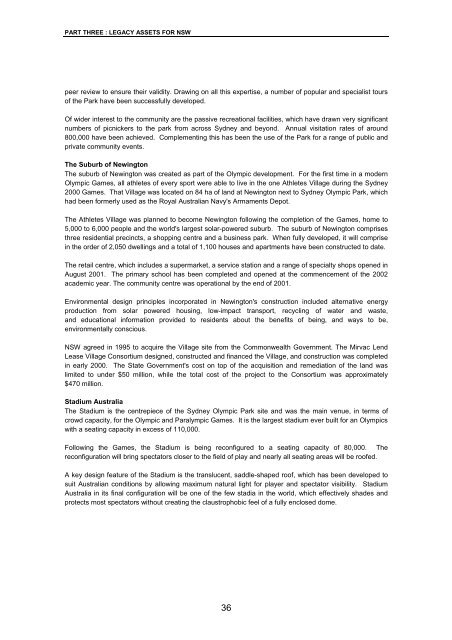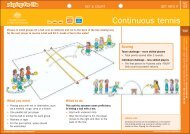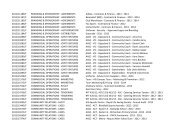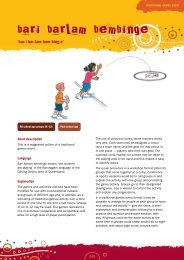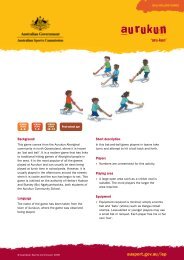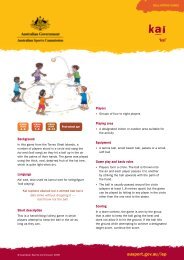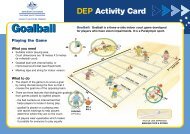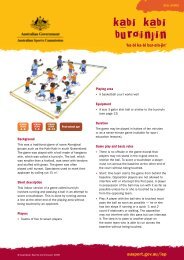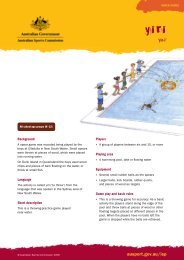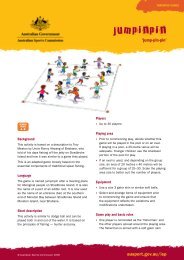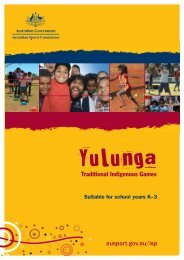the sydney 2000 olympic and paralympic games - Australian Sports ...
the sydney 2000 olympic and paralympic games - Australian Sports ...
the sydney 2000 olympic and paralympic games - Australian Sports ...
Create successful ePaper yourself
Turn your PDF publications into a flip-book with our unique Google optimized e-Paper software.
PART THREE : LEGACY ASSETS FOR NSW<br />
peer review to ensure <strong>the</strong>ir validity. Drawing on all this expertise, a number of popular <strong>and</strong> specialist tours<br />
of <strong>the</strong> Park have been successfully developed.<br />
Of wider interest to <strong>the</strong> community are <strong>the</strong> passive recreational facilities, which have drawn very significant<br />
numbers of picnickers to <strong>the</strong> park from across Sydney <strong>and</strong> beyond. Annual visitation rates of around<br />
800,000 have been achieved. Complementing this has been <strong>the</strong> use of <strong>the</strong> Park for a range of public <strong>and</strong><br />
private community events.<br />
The Suburb of Newington<br />
The suburb of Newington was created as part of <strong>the</strong> Olympic development. For <strong>the</strong> first time in a modern<br />
Olympic Games, all athletes of every sport were able to live in <strong>the</strong> one Athletes Village during <strong>the</strong> Sydney<br />
<strong>2000</strong> Games. That Village was located on 84 ha of l<strong>and</strong> at Newington next to Sydney Olympic Park, which<br />
had been formerly used as <strong>the</strong> Royal <strong>Australian</strong> Navy's Armaments Depot.<br />
The Athletes Village was planned to become Newington following <strong>the</strong> completion of <strong>the</strong> Games, home to<br />
5,000 to 6,000 people <strong>and</strong> <strong>the</strong> world's largest solar-powered suburb. The suburb of Newington comprises<br />
three residential precincts, a shopping centre <strong>and</strong> a business park. When fully developed, it will comprise<br />
in <strong>the</strong> order of 2,050 dwellings <strong>and</strong> a total of 1,100 houses <strong>and</strong> apartments have been constructed to date.<br />
The retail centre, which includes a supermarket, a service station <strong>and</strong> a range of specialty shops opened in<br />
August 2001. The primary school has been completed <strong>and</strong> opened at <strong>the</strong> commencement of <strong>the</strong> 2002<br />
academic year. The community centre was operational by <strong>the</strong> end of 2001.<br />
Environmental design principles incorporated in Newington's construction included alternative energy<br />
production from solar powered housing, low-impact transport, recycling of water <strong>and</strong> waste,<br />
<strong>and</strong> educational information provided to residents about <strong>the</strong> benefits of being, <strong>and</strong> ways to be,<br />
environmentally conscious.<br />
NSW agreed in 1995 to acquire <strong>the</strong> Village site from <strong>the</strong> Commonwealth Government. The Mirvac Lend<br />
Lease Village Consortium designed, constructed <strong>and</strong> financed <strong>the</strong> Village, <strong>and</strong> construction was completed<br />
in early <strong>2000</strong>. The State Government's cost on top of <strong>the</strong> acquisition <strong>and</strong> remediation of <strong>the</strong> l<strong>and</strong> was<br />
limited to under $50 million, while <strong>the</strong> total cost of <strong>the</strong> project to <strong>the</strong> Consortium was approximately<br />
$470 million.<br />
Stadium Australia<br />
The Stadium is <strong>the</strong> centrepiece of <strong>the</strong> Sydney Olympic Park site <strong>and</strong> was <strong>the</strong> main venue, in terms of<br />
crowd capacity, for <strong>the</strong> Olympic <strong>and</strong> Paralympic Games. It is <strong>the</strong> largest stadium ever built for an Olympics<br />
with a seating capacity in excess of 110,000.<br />
Following <strong>the</strong> Games, <strong>the</strong> Stadium is being reconfigured to a seating capacity of 80,000. The<br />
reconfiguration will bring spectators closer to <strong>the</strong> field of play <strong>and</strong> nearly all seating areas will be roofed.<br />
A key design feature of <strong>the</strong> Stadium is <strong>the</strong> translucent, saddle-shaped roof, which has been developed to<br />
suit <strong>Australian</strong> conditions by allowing maximum natural light for player <strong>and</strong> spectator visibility. Stadium<br />
Australia in its final configuration will be one of <strong>the</strong> few stadia in <strong>the</strong> world, which effectively shades <strong>and</strong><br />
protects most spectators without creating <strong>the</strong> claustrophobic feel of a fully enclosed dome.<br />
36


